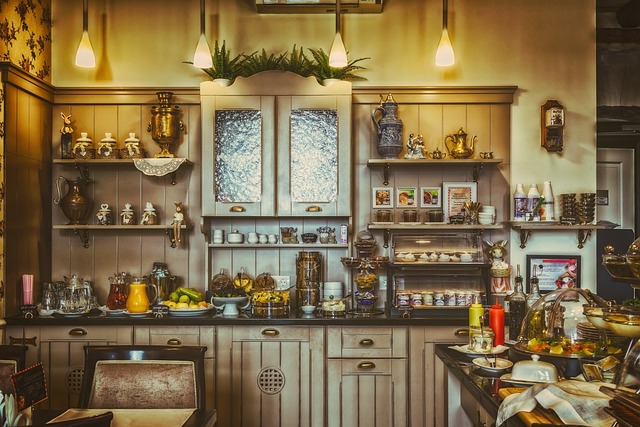Classic kitchen design ideas prioritize symmetry and balance for harmonious aesthetics and improved functionality. By aligning cabinets, countertops, and appliances with careful equilibrium, designers create elegant spaces that offer a sense of order and increased spaciousness. This approach enhances navigation and usage, transforming the kitchen into an inviting symphony of visual interest and practical organization. Achieving balance through paired elements, consistent heights, and mirrored installations ensures both timeless beauty and efficient daily routines.
Designing with symmetry and balance is key to achieving a cohesive appearance, especially in spaces like kitchens. This article explores the power of these principles in enhancing aesthetics and functionality. We delve into understanding symmetry and balance, their impact on kitchen layouts, and how to incorporate them effectively. From classic designs to modern twists, discover tips for creating a harmonious kitchen that captivates with its balanced beauty, offering a serene and inviting space for culinary creation. Explore our guide for the ultimate in classic kitchen design ideas.
Understanding Symmetry and Balance in Design
In the realm of design, symmetry and balance are fundamental principles that create a sense of harmony and coherence, especially in popular concepts like classic kitchen design ideas. Symmetry refers to the arrangement of elements on either side of a central axis, ensuring they mirror each other. This creates an orderly and visually pleasing composition. Balance, on the other hand, is achieved by distributing weight or importance across a design, making it feel stable and integrated.
In classic kitchen design ideas, these principles manifest in various ways. For instance, a symmetrically designed kitchen might feature parallel cabinets on either side of an island, with mirrors placed above each other to enhance the sense of balance. This symmetry and balance not only make the space aesthetically pleasing but also contribute to its functionality, making it easier to navigate and use.
The Role of Symmetry in Kitchen Aesthetics
Symmetry plays a pivotal role in creating a harmonious and visually appealing kitchen, forming the cornerstone of classic kitchen design ideas. By aligning elements like cabinets, countertops, and appliances with careful consideration for balance, designers can achieve an elegant and inviting space. This symmetry not only provides a sense of order but also makes the kitchen feel more spacious, enhancing its overall aesthetic appeal.
Incorporating symmetrical designs can be as simple as mirroring cabinet layouts or positioning appliances in matching pairs. For instance, aligning the sink with the stove or creating mirrored cabinets on either side of an island can instantly elevate the kitchen’s design while ensuring a balanced and cohesive look. Such symmetry contributes to a calming atmosphere, making the kitchen a soothing and enjoyable space for daily routines and entertaining guests.
Creating a Classic Kitchen Layout with Symmetry
In the realm of classic kitchen design ideas, symmetry and balance play a pivotal role in creating an harmonious and inviting space. A well-designed kitchen layout often centers around a symmetrical approach, where elements like countertops, cabinets, and appliances are mirrored or balanced to achieve visual equilibrium. This classic kitchen aesthetic not only offers a calming effect but also enhances functionality by ensuring equal distribution of weight and visual interest.
By incorporating symmetry, you can transform your kitchen into a symphony of order and elegance. For instance, placing the sink and stove on either side of an island creates a balanced composition. Similarly, aligning cabinets and countertops in a mirrored fashion across the room contributes to the cohesive appearance. This balance not only makes the space aesthetically pleasing but also simplifies movement and organization, making daily routines more efficient and enjoyable.
Incorporating Balancing Elements in Kitchen Design
In a classic kitchen design, balance and symmetry are key elements that contribute to a cohesive and harmonious space. One effective way to achieve this is by incorporating balancing elements strategically throughout the layout. For instance, placing a large island or a substantial countertop on one side of the room can be counterbalanced with an equal weight on the other side, whether it’s through a well-positioned dining table or a set of upper cabinets. This visual equilibrium not only creates a pleasing aesthetic but also enhances functionality, ensuring that the kitchen feels both inviting and organised.
When designing classic kitchen spaces, paying attention to proportions is equally important. Balancing larger features with smaller ones helps to maintain visual harmony. A grand chandelier above the dining table, for instance, can be complemented by smaller decorative accents scattered throughout the room. This subtlety in scaling ensures that no single element dominates the space, fostering a sense of balance and elegance that is characteristic of timeless kitchen design ideas.
Tips for Achieving Cohesive Symmetry in Your Kitchen
Achieving symmetry and balance in your kitchen is key to creating a cohesive and aesthetically pleasing space. One effective tip is to arrange appliances and cabinets in pairs, aligning them for an even distribution of weight and visual appeal. For instance, if you have a pair of oven ranges, position them symmetrically on either side of the kitchen island or wall. This simple trick creates harmony and makes your classic kitchen design ideas come alive.
Consider the height and scale of fixtures to maintain balance. Countertops, cabinets, and shelves should have parallel lines and consistent heights to reinforce symmetry. Incorporate mirrors or mirrored surfaces in smaller areas to expand space and create visual equilibrium. By combining these strategies, you’ll find that your kitchen not only looks stunning but also feels inviting and well-organized.
Designing kitchens with symmetry and balance creates a harmonious, cohesive look that enhances overall aesthetics. By understanding the principles of symmetry and incorporating balancing elements, you can achieve a classic kitchen design that not only looks stunning but also feels inviting and functional. Whether focusing on kitchen layout or specific design elements, these strategies are key to crafting beautiful, enduring classic kitchen design ideas.
